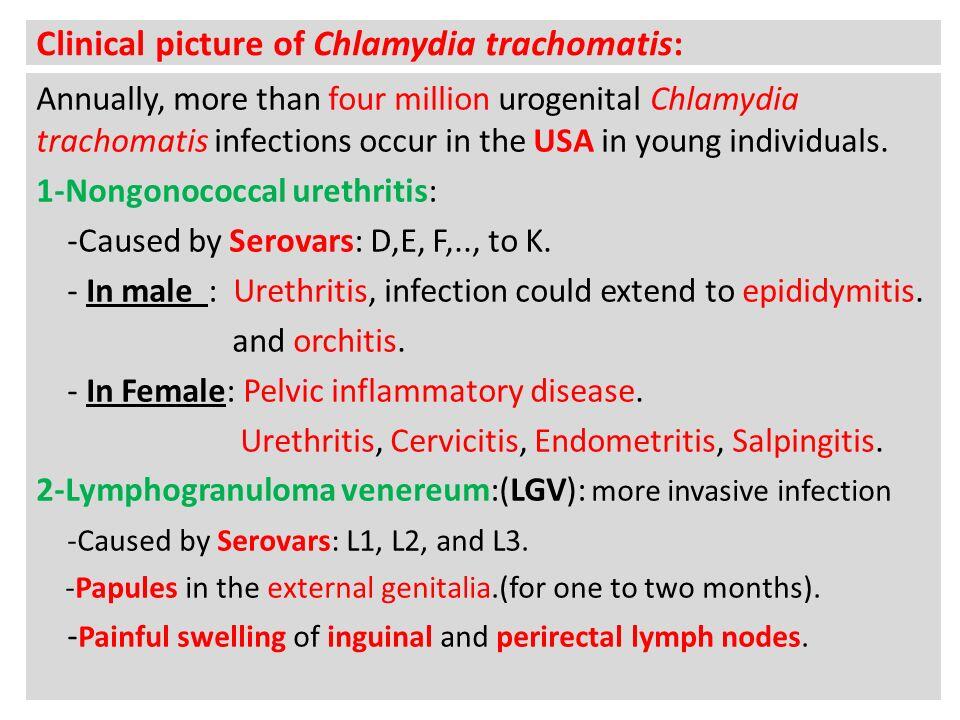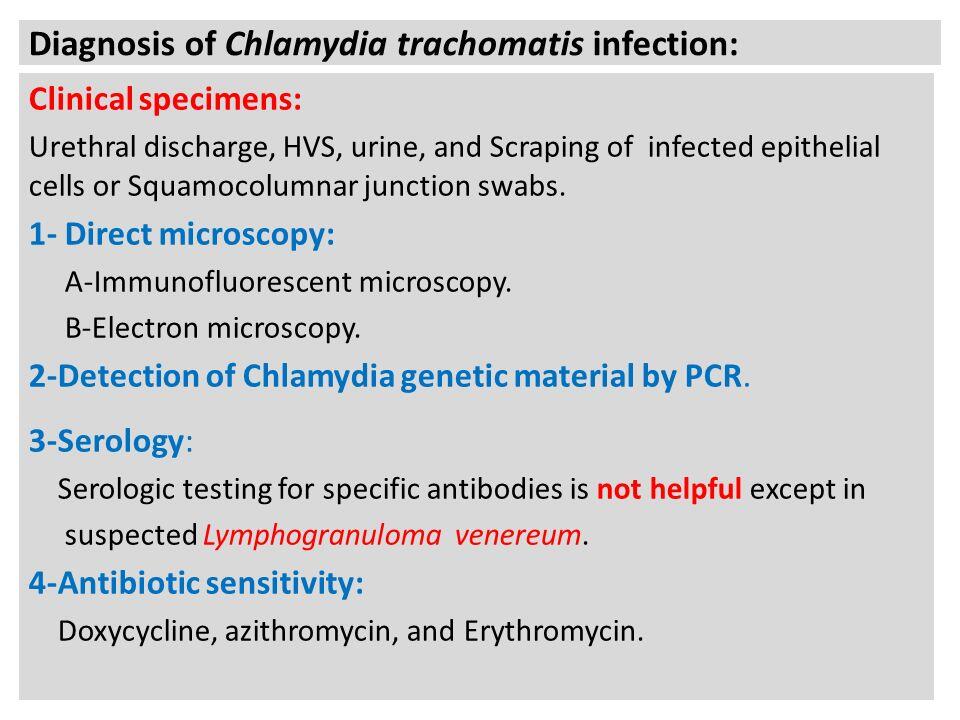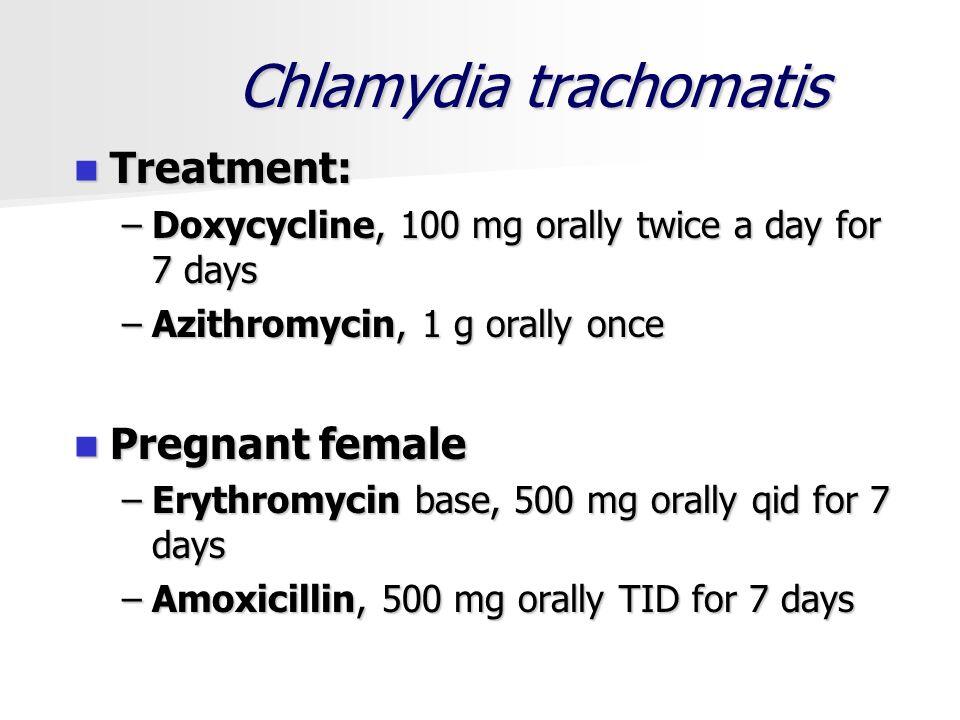Essentials of Diagnosis
- Typical intracytoplasmic inclusions in Giemsa-stained cell scrapings from the conjunctiva.
- Ligase chain reaction (LCR) or polymerase chain reaction (PCR) in first-void urine.
- Positive culture in McCoy or HeLa cells of body fluids or secretions.
- Positive microimmunofluorescence serology for suspected cases of lymphogranuloma venereum and infants with pneumonia.
- Complement fixation titer of 1:64 or greater in patients with presumed lymphogranuloma venereum.
Clinical Syndromes
C trachomatis is associated with urethritis, proctitis, conjunctivitis, and arthritis in women and men; epididymitis in men; and mucopurulent cervicitis (MPC), acute salpingitis, bartholinitis, and the Fitz-Hugh and Curtis syndrome in women (Box 1). C trachomatis and Neisseria gonorrhoeae (see site) coinfections are common in women with MPC and men with urethritis. In men, C trachomatis is the most common etiologic agent of the nongonococcal (NGU) and postgonococcal urethritis (PGU) syndromes. In college-age women, in the absence of infection with Escherichia coli or Staphylococcus saprophyticus, C trachomatis is the most common etiologic agent of urethritis.
Urethritis
Urethritis is characterized in women by the presence of dysuria and frequency without urgency or hematuria and in men by discharge, frequency, and dysuria. Urethritis should be documented by the presence of mucopurulent or purulent discharge, by a Gram stain of urethral secretions demonstrating = 5 leukocytes per oil immersion field, or by demonstrating a positive leukocyte esterase test or = 10 leukocytes per high-power field on first-void urine. NGU is diagnosed in men with urethritis in whom gram-negative intracellular diplococci (N gonorrhoeae) cannot be detected in a gram-stained urethral discharge or swab specimen.
PGU is diagnosed in men with persistent urethritis 2-3 weeks after treatment of gonococcal urethritis with beta-lactam antibiotics, which are ineffective against C trachomatis. Although the discharge from chlamydial urethritis is more watery, less purulent, and less abundant than the discharge from gonococcal urethritis, attempts to distinguish between the two on clinical grounds alone can be problematic. Physical examination in cases of chlamydial urethritis can be entirely normal or reveal meatal erythema and tenderness, urethral discharge, or both. It should be emphasized that asymptomatic C trachomatis infections can lead to long-term sequelae in the genitourinary tract.
Mucopurulent Cervicitis
MPC is defined by the presence of mucopurulent or purulent endocervical discharge in the endocervical canal or in an endocervical swab specimen. It has been suggested that the diagnosis can also be made on the basis of easily induced cervical bleeding. The most common complaints are vaginal discharge, vaginal bleeding, abdominal pain, and dysuria, although most infected women are asymptomatic.
Physical examination reveals cervical edema, ectopy, and a propensity of the endocervical mucosa to bleed when rubbed with a swab.
Proctitis
Proctitis can be caused by C trachomatis serovars D through K and serovars L1, L2, and L3. It occurs primarily in men who have sex with men and practice receptive anorectal intercourse.
It can occur also in heterosexual women. Patients usually present with rectal pain, tenesmus, and rectal exudate; hematochezia may be present. Gram stain of the rectal discharge reveals neutrophils.
Anoscopic examination reveals mucopurulent discharge with a patchy mucosal friability of the distal third segment of the rectum. The L1, L2, and L3 strains rarely cause disease in the United States and produce a more severe syndrome of ulcerative proctitis or even proctocolitis; this presentation can be confused with herpes simplex virus (HSV) proctitis or Crohn’s disease. Proctocolitis can lead to perianal fistulas and rectal strictures.
Lymphogranulom
Venereum C trachomatis serovars L1, L2, and L3 are also responsible for the syndrome of lymphogranuloma venereum (LGV). The most frequent manifestation of LGV among heterosexual men is tender unilateral inguinal or femoral lymphadenopathy or both. The lymphadenopathy becomes associated with perinodal inflammation and formation of a bubo. Men who have sex with men and women may present with the proctocolitis syndrome (see above). Most patients present at the time of lymphadenopathy and no longer have the primary painless self-limited nodular or ulcerative lesion at the inoculation site.
Epididymitis
Epididymitis should be suspected in patients with unilateral testicular pain, with or without fever, and unilateral epididymal tenderness or swelling on physical examination. In men younger than 35 years, C trachomatis is by far the most common etiologic agent, followed by N gonorrhoeae. In men older than 35, E coli and Pseudomonas aeruginosa are the most common etiologic agents; these infections usually occur in the setting of urologic manipulation. In each case of suspected epididymitis, torsion of the ipsilateral testicle should be ruled out. Clinically available tests to rule out testicular torsion include Doppler ultrasound and nuclear medicine studies. In patients in whom the clinical suspicion for testicular torsion is high (eg, a young person who presents with acute unilateral testicular pain without urethritis), surgical exploration may be indicated. In patients with chronic unilateral testicular pain who do not respond to appropriate antibacterial therapy, other etiologies such as carcinoma or tuberculosis should be considered.
Pelvic Inflammatory Disease
Pelvic inflammatory disease (PID) comprises a spectrum of inflammatory disorders of the female upper genital tract, including any combination of endometritis, salpingitis, tubo-ovarian abscess, and pelvic peritonitis. C trachomatis and N gonorrhoeae are the two most common etiologic agents.
Other organisms such as anaerobes, Streptococcus agalactiae, Gardnerella vaginalis, enteric gram-negative bacilli, Ureaplasma urealyticum, and Mycoplasma hominis have also been implicated as etiologic agents of PID. PID can present with subtle or mild symptoms and may also be asymptomatic. Initially, symptoms may not necessarily indicate involvement of the genital tract. PID should be suspected in sexually active women who present with lower abdominal pain or tenderness, adnexal tenderness, and/or cervical motion tenderness and in whom no other cause for these symptoms can be identified.
Other causes of abdominal pain in this setting include ectopic pregnancy and acute appendicitis. In addition, PID can present with fever (>101 °F), abnormal vaginal or cervical discharge, vaginal bleeding, dyspareunia, or some combination of these symptoms. Erythrocyte sedimentation rate or C-reactive protein may be elevated.
Reiter’s Syndrome
Reiter’s syndrome consists of conjunctivitis or uveitis, urethritis, arthritis, and mucocutaneous lesions that usually occur in human leukocyte antigen (HLA)-B27-positive individuals ~ 1-6 weeks after acquisition of a sexually transmitted or dysenteric agent. The first three features constitute the classic triad. Reiter’s syndrome can present with all of the features mentioned above or in any combination of those symptoms. NGU may in fact be the first sign of this syndrome. In women, cervicitis can be part of the syndrome. The knees are the most commonly affected joints. Reiter’s has been described after infection with enteric pathogens such as Salmonella, Shigella, or Campylobacter species, as well as C trachomatis genital-tract infection.
Perinatal Infections
Perinatal infections with C trachomatis result from exposure of the neonate to the organism present in the mother’s cervix. Initial infection results in colonization of the mucous membranes of the eye, oropharynx, urogenital tract, and rectum. Infection of the newborn with C trachomatis is first manifested by the presence of conjunctivitis, which usually develops between 5 and 14 days after birth.
Other infectious agents capable of causing conjunctivitis in neonates include N gonorrhoeae, Haemophilus influenzae, S pneumoniae, and HSV. Typically, N gonorrhoeae has an incubation period of only 1-3 days. However, laboratory tests are required for a microbiologic diagnosis.
Pneumonia can develop in neonates as a subacute, afebrile respiratory syndrome with onset at between 1 and 3 months of age. Infants usually develop cough, tachypnea, and bilateral diffuse interstitial infiltrates. Neonatal infections of the oropharynx, genital tract, and rectum are usually asymptomatic.
Eye Infections
C trachomatis causes eye disease in children and adults, and this disease takes two distinct clinical and epidemiological forms: trachoma and adult inclusion conjunctivitis. Trachoma is a chronic inflammatory condition of the ocular and palpebral conjunctiva and cornea caused by C trachomatis serovars A, B, Ba, and C. It occurs in the setting of poor hygiene and crowded conditions.
A follicular conjunctivitis is usually followed by superficial neovascularization of the cornea (pannus formation). Subsequent scarring of the conjunctiva and cornea eventually leads to blindness.
Adult inclusion conjunctivitis results from sexual transmission of C trachomatis serovars D through K. It usually presents as an acute unilateral follicular conjunctivitis and periauricular lymphadenopathy; this presentation is clinically similar to that of adenovirus or HSV conjunctivitis. If left untreated, it can evolve into a syndrome of chronic conjunctivitis but rarely results in conjunctival or corneal scarring.
Diagnosis
Urethritis
In men with suspected nongonococcal or postgonococcal urethritis, the diagnosis of urethritis should be confirmed based on the results of urinalysis with = 10 leukocytes per high-power field or on Gram stain examination of the urethral discharge revealing > 4 neutrophils per oil immersion field. The absence of N gonorrhoeae should be documented with a properly performed Gram stain examination of the urethral material. Nucleic acid amplification methods for use with either urine or urethral/cervical swab specimens are the most sensitive and specific tests for the definitive diagnosis of C trachomatis genital-tract infection. The two most commonly used amplification methods are LCR and PCR. Since these methods can be used with first-void urine, an uncomfortable swab procedure is not necessary, thereby facilitating widespread diagnostic testing and screening of populations at risk.
Epididymitis, Proctitis, and Mucopurulent Cervicitis
In young men with epididymitis, urethritis needs to be ruled out (see preceding section). In a similar fashion, N gonorrhoeae should be excluded in patients who have both testicular pain and urethral discharge. Amplification of C trachomatis DNA from urine based on PCR or LCR is the diagnostic approach of choice. This sensitive and specific approach has also replaced cervical-swab specimen culture for assessing the possibility of C trachomatis cervicitis. For the diagnostic workup of proctitis, a rectal culture or direct immunofluorescence test for C trachomatis is indicated.
PID
The diagnosis of PID is difficult. Symptoms, signs, and laboratory tests are not specific. Women with symptomatic PID can present with any combination of the following: pelvic pain including adnexal and/or cervical-motion tenderness, palpable adnexal mass, and/or elevated erythrocyte sedimentation rate, C-reactive protein, or peripheral leukocyte count.
Reiter’s Syndrome
In those with clinical features of Reiter’s syndrome, evidence of C trachomatis should be sought. A stool examination should also be performed for the gastrointestinal-tract pathogens associated with Reiter’s syndrome, and the possibility of the HLA-B27 haplotype should be assessed.
Lymphogranuloma Venereum
The diagnosis of LGV is confirmed by isolation of an LGV serovar from the lymph node or rectum and occasionally from the urethra or cervix. An LGV complement fixation titer of = 1:64 or a microimmunofluorescence titer of = 1:512 is considered diagnostic.
Perinatal Infections
Purulent conjunctival discharge in a neonate should be evaluated with Gram stain and bacterial cultures to rule out N gonorrhoeae, Haemophilus spp., S pneumoniae, and Staphylococcus aureus. C trachomatis antigen can be detected directly, and the organism can be cultivated from conjunctival discharge. A Giemsa-stained scraping of the conjunctiva is less sensitive for detecting Chlamydia cells but is the most rapid method for diagnosis. Chlamydial culture of sputum, pharynx, eye, and rectum should be obtained in infants with pneumonia. Serological tests may help if a fourfold change is observed in immunoglobulin (Ig) G or IgM titers, but a single IgG measurement may be misleading because of passive transfer of maternal antibody. The two samples should be obtained = 4 weeks apart and analyzed in parallel.
Eye Infections
Trachoma can be diagnosed on clinical grounds and in the proper epidemiological setting. Confirmation of the diagnosis can be achieved by Giemsa-stained cell scrapings from the conjunctiva and detection of typical intracytoplasmic inclusions.
Treatment
Urethritis
Adults with NGU or PGU should be treated as soon as possible after diagnosis. A single-dose regimen based on azithromycin for example has the important advantage of improved adherence (Box 67-2). Doxycycline, erythromycin, or ofloxacin can also be used. Ofloxacin is also often effective against N gonorrhoeae. Other drugs used against N gonorrhoeae such as the cephalosporins and ciprofloxacin are not effective against C trachomatis.
Patients with recurrent or persistent urethritis should be evaluated for the possibility of nonadherence, reinfection, or an alternative diagnosis. In this setting, patients should be re-treated if they do not comply fully or have been re-exposed to an untreated sex partner. A combination regimen consisting of metronidazole plus erythromycin has been suggested for patients with a history of recurrent urethritis, who have adhered to the initial regimen and have not been re-exposed. In the absence of reliable negative data for N gonorrhoeae, empiric antibiotic coverage for this organism should be provided as well.
Mucopurulent Cervicitis, Proctitis, Epididymitis, and PID
Patients with mucopurulent cervicitis, proctitis, and epididymitis should be tested for C trachomatis and N gonorrhoeae, as above, and treated with drugs effective against both (Box 2). PID is managed similarly, except that antimicrobial coverage against anaerobes is often included. In addition, treatment is often begun via an intravenous route. Erythromycin is the drug of choice for pregnant women with C trachomatis infection; amoxicillin has also been successful in this setting. Single-dose azithromycin is another alternative during pregnancy. Tetracyclines and fluoroquinolones are contraindicated in pregnant women.
Lymphogranuloma Venereum
LGV is treated with doxycycline (Box 3). Alternative drugs include macrolides such as erythromycin. The activity of azithromycin against C trachomatis suggests that it may be effective in treating LGV given in multiple doses over 2-3 weeks, but clinical data regarding its use for this disease are lacking.
Patients with suspected or proven C trachomatis infection should be instructed to refer their sex partners (sexual contacts during the 60 days preceding onset of symptoms or diagnosis of chlamydial infection) for diagnostic testing, treatment, or both. However, the last sexual contact should be treated even if the time of the last sexual contact was > 60 days before onset of symptoms or diagnosis. Patients and their sex partners should abstain from sexual activity until treatment courses are completed.
Unless symptoms persist or reinfection is suspected, patients treated with doxycycline or azithromycin do not need to be retested for chlamydial infection because these drugs are highly effective. A test of cure may be considered 3 weeks after completion of a course of erythromycin.
Perinatal Infection
Erythromycin is the drug of choice for infants with C trachomatis ocular infection, as well as with C trachomatis pneumonia (Box 4). Mothers of infants with chlamydial infection and the sex partners of these women should be assessed and treated for C trachomatis infection. Newborns of mothers who have untreated chlamydial infections should be monitored closely for symptoms of conjunctivitis or pneumonia. Prophylactic antibiotics are not indicated in this setting.
Infections in Young Children
Chlamydial infections in preadolescent children should raise the possibility of sexual abuse. Because of the potential for a criminal investigation, the diagnosis of C trachomatis in this situation requires isolation in cell culture.
In children who weigh < 45 kg, erythromycin is the drug of choice. In children who weigh = 45 kg but who are < 8 years of age, azithromycin is the drug of choice. In children, = 8 years of age, doxycycline can be used as an alternative to azithromycin. (See Box 2.)
Eye Infections
Patients with trachoma conjunctivitis respond well to a tetracycline, azithromycin, or erythromycin (Box 4). Public health programs for management of endemic trachoma consist of mass application of tetracycline or erythromycin ophthalmic ointment to all children in affected communities for 21-60 days or on an intermittent basis. Surgical correction of eyelids is also undertaken.
Adult inclusion conjunctivitis is usually treated with an oral tetracycline or erythromycin. All sexual contacts should be evaluated, treated for C trachomatis infection, or both.
Prevention
Programs aimed at the detection of asymptomatic chlamydial infection and treatment of both symptomatic and asymptomatic cases have proven to be effective in decreasing the prevalence of Chlamydia infections in the United States. In addition, behavioral interventions designed for primary prevention of STDs are of paramount importance. A sexual history should be obtained from all patients who are sexually active as a first step in identifying patients at risk and in delivering prevention messages. A professional, compassionate, and nonjudgmental attitude is essential.
The most effective strategy for prevention of STDs is avoidance of infected sex partners; however, this is difficult given the prevalence of asymptomatic infection. Information should be provided regarding abstinence especially to those who are being treated for an STD or whose partners are undergoing treatment. T
he direct relationship between the number of sex partners and the likelihood of STDs must be discussed. A vaccine against chlamydial disease has not yet been developed. Institution of basic hygienic practices such as hand washing is beneficial in reducing the prevalence of trachoma. In addition, mass treatment with azithromycin appears to result in markedly decreased levels of disease.






